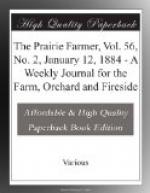* * * * *
M. Pasteur, the eminent French scientist, says epizootic hog-cholera, even of the most virulent type, can be prevented by inocculation with the attenuated virulent virus. He also says it is proven that the period of immunity is more than a year; that, consequently, this is long enough for the requirements of hog-raising, since the period of fattening does not generally exceed a year. Yet, in spite of these happy results, I repeat that the question of the use of vaccination for different breeds needs new investigation, so that the vaccination of swine may be made general.
THE DAIRY
Dairymen, Write for Your Paper.
WINTER FEED FOR COWS.
The increasing demand for milk in our cities and villages, and for gilt-edged butter during the winter season, is leading some of our most intelligent farmers to study more carefully the problem of winter dairying. “It costs more to make butter in winter than in summer,” says the American Agriculturalist, “but if a select class of customers in cities or elsewhere, are willing to pay for the increased cost of producing it fresh in zero weather, then there is no good reason why they should not be gratified. Its feasibility is already established on a small scale, and there seems to be no discernible limit to the demand for a first-class article during the six months when the pastures are barren. The farmer who has the capital can readily provide a barn that will make his cows nearly as comfortable and healthy in winter as in summer, and shelter all the food they need to keep up a constant flow of rich milk. We have not attained, perhaps, all the information necessary to secure the best rations for winter milking, yet we are approximating toward that knowledge. Some think they have found in ensilage the one thing needful. Yet, some of the parties dealing in gilt-edge butter begin to complain of that made from rations consisting largely of ensilage. We shall probably have to put down early cut hay with the flavor of June grass in it as an essential part of the winter rations for first-class butter. We doubt if the bouquet of the June made article can be found elsewhere. Another ration will be Indian meal, our great national cereal, which is abundant and cheap and likely to continue so. Then we want green, succulent food with the dry fodder to sharpen the appetite and help the digestion. This suggests roots as another ration. We have carrots, mangolds and sugar beets; all easily raised, and cheaply stored in barn cellars or pits. And from our own experience in using them during several winters in connection with dry feed, we judge them to be a safe ration in butter-making. Cabbage also is available, and in districts remote from large markets, might be grown for this purpose. Near cities it is probably worth more for human food than for fodder. The whole subject is yet in the tentative state, and all are looking for further light!”




